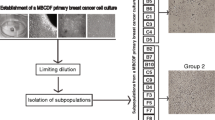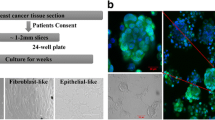Abstract
We established a novel cancer cell line (MAST) from the ascitic fluid of a metastatic infiltrating ductal carcinoma of the breast. The epithelial and neoplastic nature of the MAST cells was confirmed by ultrastructural analysis. The cell line was maintained as a monolayer with a doubling time of about 68 h, and it possessed an abnormal karyotype with a modal chromosome number of 60, a trisomy of chromosome 18 and other unidentified rearranged chromosomes. Among the markers consistently found in MAST metaphases, we noted a t(14; 14) and a very large subtelocentric, a large satellited acrocentric and a very large submetacentric chromosome with striking fluorescent bands. Immunoenzymatic assay demonstrated that the MAST cell line was positive for estrogen and progesterone receptors. The in vitro drug-sensitivity assay showed a marked resistance of the cell line to 5-fluorouracil and 4-hydroperoxycyclophosphamide and a moderate resistance to etoposide and 4′-epidoxorubicin. The molecular analysis showed a four- to sixfold amplification of the c-myc gene and no amplification or rearrangement of theint-2, c-erbB-2, c-Ha-ras, c-mos andhst-1 genes.
Similar content being viewed by others
References
Amadori D, Bertoni L, Flamigni A, Savini S, De Giovanni C, Casanova S, De Paola F, Amadori A, Giulotto E, Zoli W (1993) Establishment and characterization of a new cell line from a primary human breast carcinoma. Breast Cancer Res Treat 28:251–260
Ausubel FM, Brent R, Kingston RE, Moore DD, Seidman JG (1989) In: Current protocols in molecular biology. Wiley, New York
Casey G, Smith R, McGillivray D, Peters G, Dickson C (1986) Characterization and chromosome assignment of the human homolog ofint-2, a potential proto-oncogene. Mol Cell Biol 6:502–510
Dalla Favera R, Martinotti S, Gallo RC, Erikson J (1983) Translocation and rearrangement of the c-myc oncogene locus in human undifferentiated B-cell lymphomas. Science 219:963–967
Devilee P, Cornelisse CJ (1994) Somatic genetic changes in human breast cancer. Biochim Biophys Acta 1198:113–130
Dutrillaux B, Lejuene J (1975) New techniques in the study of human chromosomes: methods and applications. Adv Hum Genet 5:119–156
Engel LW, Young NA (1978) Human breast carcinoma cells in continuous culture: a review. Cancer Res 38:4327–4339
Ito I, Yoshimoto M, Iwase T, Watanabe S, Katagiri T, Harada Y, Kasumi F, Yasuda S, Mitomi T, Emi M, Nakamura Y (1995) Association of genetic alterations on chromosome 17 and loss of hormone receptors in breast cancer. Br J Cancer 71:438–441
King CR, Kraus MH, Aaronson SA (1985) Amplification of a novel v-erbB-related gene in a human mammary carcinoma. Science 229:974–976
Meltzer P, Leibovitz A, Dalton W, Villar H, Kute T, Davis J, Nagle R, Trent J (1991) Establishment of two new cell lines derived from human breast carcinomas with HER-2/neu amplification. Br J Cancer 63:727–735
Minafra S, Morello V, Glorioso F, La Fiura AM, Tomasino RM, Feo S, McIntosh D, Wolley DE (1989) A new line (8701-BC) from primary ductal infiltrating carcinoma of human breast. Br J Cancer 60:185–192
Negrini M, Castagnoli A, Pavan JW, Sabbioni S, Araujo D, Collarini A, Gualandi F, Rimessi P, Bonfatti A, Giunta C, Sensi A, Stanbridge EJ, Barbanti-Brodano G (1992) Suppression of tumorigenity and anchorage-independent growth of BK virustransformed mouse cells by human chromosomes 11. Cancer Res 52:1297–1303
Pandis N, Jin Y, Gorunova L, Petersson C, Bardi G, Idvall I, Johansson B, Ingvar C, Mandahl N, Mitelman F, Heim S (1995) Chromosome analysis of 97 primary breast carcinomas. Genes, chromosomes and cancer 12:173–185
Pulciani S, Santos E, Lauver AV, Long LK, Barbacid M (1982) Transforming genes in human tumors. J Cell Biochem 20:51–61
Roncuzzi L, Zoli W, Bajorko P, Gasperi-Campani A (1995) In vitro potentiation by lonidamine of the sc-RIP Saporin 6 effect in a human metastatic breast cancer cell line. Anticancer Res 15:773–776
Southern EM (1975) Detection of specific sequences among DNA fragments separated by gel electrophoresis. J Mol Biol 98:503–517
Taira M, Yoshida T, Miyagawa K, Sakamoto H, Terada M, Sugimura T (1987) cDNA sequence of human transforming gene hst and identification of the coding sequence required for transforming activity. Proc Natl Acad Sci USA 84:2980–2984
Tonigawa N, Kern DH, Hikasa Y, Norton DL (1982) Rapid assay for evaluating the chemosensitivity of human tumors in soft-agar culture. Cancer Res 42:2159–2164
Van de Vijver MJ (1993) Molecular genetic changes in human breast cancer. Adv Cancer Res 61:25–56
Whatson R, Oskarsson M, Vande Woude GF (1982) Human DNA sequence homologous to the transforming gene (mos) of moloney murine sarcoma virus. Proc Natl Acad Sci USA 79:4078–4082
Author information
Authors and Affiliations
Rights and permissions
About this article
Cite this article
Zoli, W., Roncuzzi, L., Flamigni, A. et al. A new cell line from human infiltrating ductal carcinoma of the breast: establishment and characterization. J Cancer Res Clin Oncol 122, 237–242 (1996). https://doi.org/10.1007/BF01209652
Received:
Accepted:
Issue Date:
DOI: https://doi.org/10.1007/BF01209652




